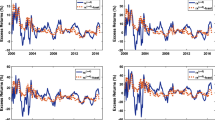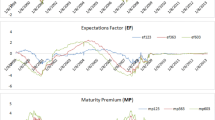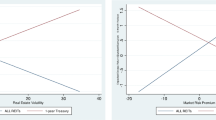Abstract
Using a rich data set for the UK for over a century, we find that the relation between the equity risk premium and the government bond maturity premium is nonlinear and subject to stochastic regime switching. We identify a regime in which both premia are jointly characterized by low volatility and another regime in which both premia are characterized by high volatility. The occurrence of the high volatility regime chronologically coincides with major changes in the pound exchange rate. The low volatility regime has a higher probability of turning up over two consecutive years than the high volatility regime, but it is not perceived by investors to be an absorbing regime. The lagged maturity premium is a strong predictor of the equity risk premium only in the regime of low volatility. In addition, the lagged equity premium is a predictor of the maturity premium also in the low volatility regime. This result on regime-dependent bidirectional predictability is robust to alternative definitions of the equity premium, and to the inclusion of real interest rate and real growth effects.


Similar content being viewed by others
Notes
Strictly speaking, long term government bonds are risk free only in the sense that they normally offer a fixed income and the likelihood of default is very small. In all other respects, they are riskier than bills.
The data source for the real interest rate and the real growth rate is the Global Financial Data provider.
A VAR with 0 lags was estimated but there was evidence of serial correlation. We have also estimated a second order VAR, but the second order lags were not statistically significant.
Using the usual LR test is problematic because the LR test does not have the standard asymptotic distribution. The problem comes from the fact that under the null hypothesis, some parameters are not identified and the scores are identically zero. To overcome this problem, we employ the non-standard LR bound test proposed by Davies (1987).
Exactly the same results hold for the alternative definition of the equity premium in terms of bonds.
For an extensive analysis of the stock-bond correlations, see Addona and Kind (2006).
These authors found that recessions lead to increases in stock market volatility.
In Tables 5 and 6, the equity risk premium is defined in terms of the Treasury bill yield. Using the alternative definition of the equity premium in terms of the long-term bond yield does not change qualitatively the results. The results are not reported to save space, but are available upon request.
References
Addona S, Kind AH (2006) International stock-bond correlations in a simple affine asset pricing model. J Bank Financ 30:2747–2765
Barberis N (2000) Investing for the long run when returns are predictable. J Finance 55:225–264
Baur D, Lucey BM (2006) Flight-to-quality or contagion? An empirical analysis of stock-bond correlations, Working Paper, Trinity College Dublin, October
Black A, Fraser P (1995) UK stock returns: predictability and business conditions. Manch Sch Suppl 63:85–102
Boudoukh J, Richardson M, Whitelaw RF (1997) Nonlinearities in the relation between the equity risk premium and the term structure. Manage Sci 43(3):371–385
Brandt M (1999) Estimating portfolio and consumption choice: a conditional Euler equations approach. J Finance 54:655–671
Campbell JY (1987) Stock returns and the term structure. J Financ Econ 18:373–389
Campbell JY, Ammer J (1993) What moves the stock and bond markets? A variance decomposition for long-term asset returns. J Finance 48:3–37
Campbell JY, Hamao Y (1989) Predictable stock returns in the United States and Japan: a study of long-term capital market integration. LSE Financial Markets Discussion Paper
Campbell JY, Viceira L (1999) Consumption and portfolio decisions when expected returns are time varying. Q J Econ 114:433–495
Chen N (1991) Financial investment opportunities and the macroeconomy. J Finance 46:529–554
Chen S-S (2007) Does monetary policy have asymmetric effects on stock returns? J Money Credit Bank 39:667–688
Clare A, Thomas S, Wickens M (1994) Is the gilt-equity yield ratio useful for predicting UK stock returns? Econ J 104:303–315
Davies RB (1987) Hypothesis testing when the nuisance parameter is present only under the alternative. Biometrika 74:33–43
Dimson E, Marsh P (2001) UK financial market returns. J Bus 74(1):1–13
Dimson E, Marsh P, Staunton M (2000) Risk and return in the 20th and 21st centuries. Bus Strateg Rev 11(2):1–18
Dimson E, Marsh P, Staunton M (2002) Triumph of the optimists: 101 years of global investment returns. Princeton University Press, Princeton
Dimson E, Marsh P, Staunton M (2003) Global investment returns yearbook, 2003. ABN-AMRO, Amsterdam
Dimson E, Marsh P, Staunton M (2007) The worldwide equity premium: a smaller puzzle. In: Mehra R (ed) Handbook of investments: equity risk premium. North Holland, Amsterdam
Estrella A, Hardouvelis G (1991) The term structure as predictor of real economic activity. J Finance 46:555–576
Fama EF, French KR (1988) Dividend yields and expected stock returns. J Financ Econ 22:3–25
Fama EF, French KR (1989) Business conditions and expected returns on bonds and stocks. J Financ Econ 25:23–49
Fama EF, French KR (1993) Common risk factors in the returns on stocks and bonds. J Financ Econ 33:3–56
Fama EF, Schwert GW (1977) Asset returns and inflation. J Financ Econ 5:115–146
Fitzgerald A (1992) The equity risk premium puzzle. Briefing paper 24, Nat West Securities
Fraser P (1995) UK stock and government bond returns: predictability and the term structure. Appl Financ Econ 5:61–67
Guidolin M, Timmermann A (2005) Economic implications of bull and bear regimes in UK stock and bond returns. Econ J 115:111–143
Hamilton JD (1989) A new approach to the economic analysis of nonstationary time series and the business cycle. Econometrica 57:357–384
Hamilton JD, Lin G (1996) Stock market volatility and the business cycle. J Appl Econ 11:573–593
Harvey C (1988) The real term structure and consumption growth. J Financ Econ 22:305–333
Kandel S, Stambaugh R (1996) On the predictability of stock returns: an asset allocation perspective. J Finance 51:385–424
Krolzig H-M (1997) Markov-switching vector autoregressions. Springer, Berlin
Lekkos I, Milas C (2004) Time-varying excess returns on UK government bonds: a non-linear approach. J Bank Financ 28:45–62
Ludvigson S, Ng S (2006) Macro factors in bond risk premia. Working Paper, Department of Economics, New York University
O’Hanlon J, Steele A (2000) Estimating the equity risk premium using accounting fundamentals. J Bus Finance Account 27(9–10):1051–1083
Pesaran M, Timmermann A (2000) A recursive modeling approach to predicting stock returns. Econ J 110:159–191
Shah M, Wadhwani S (1990) The effect of the term spread, dividend yield and real activity on stock returns: evidence from 15 countries. LSE Financial Markets Group Discussion Paper, No 98
Timmermann A (2000) Moments of Markov-switching models. J Econ 96:75–111
Author information
Authors and Affiliations
Corresponding author
Rights and permissions
About this article
Cite this article
Kanas, A. The relation between the equity risk premium and the bond maturity premium in the UK: 1900–2006. J Econ Finance 33, 111–127 (2009). https://doi.org/10.1007/s12197-008-9038-2
Published:
Issue Date:
DOI: https://doi.org/10.1007/s12197-008-9038-2




